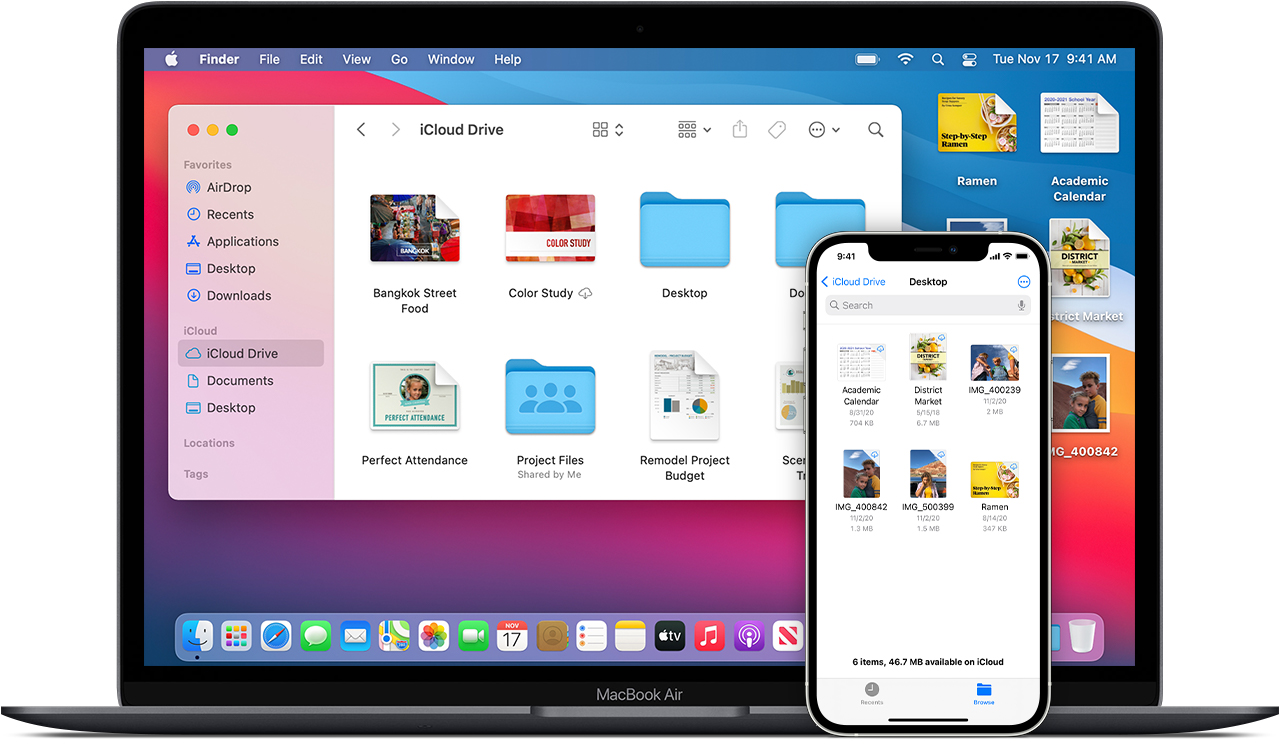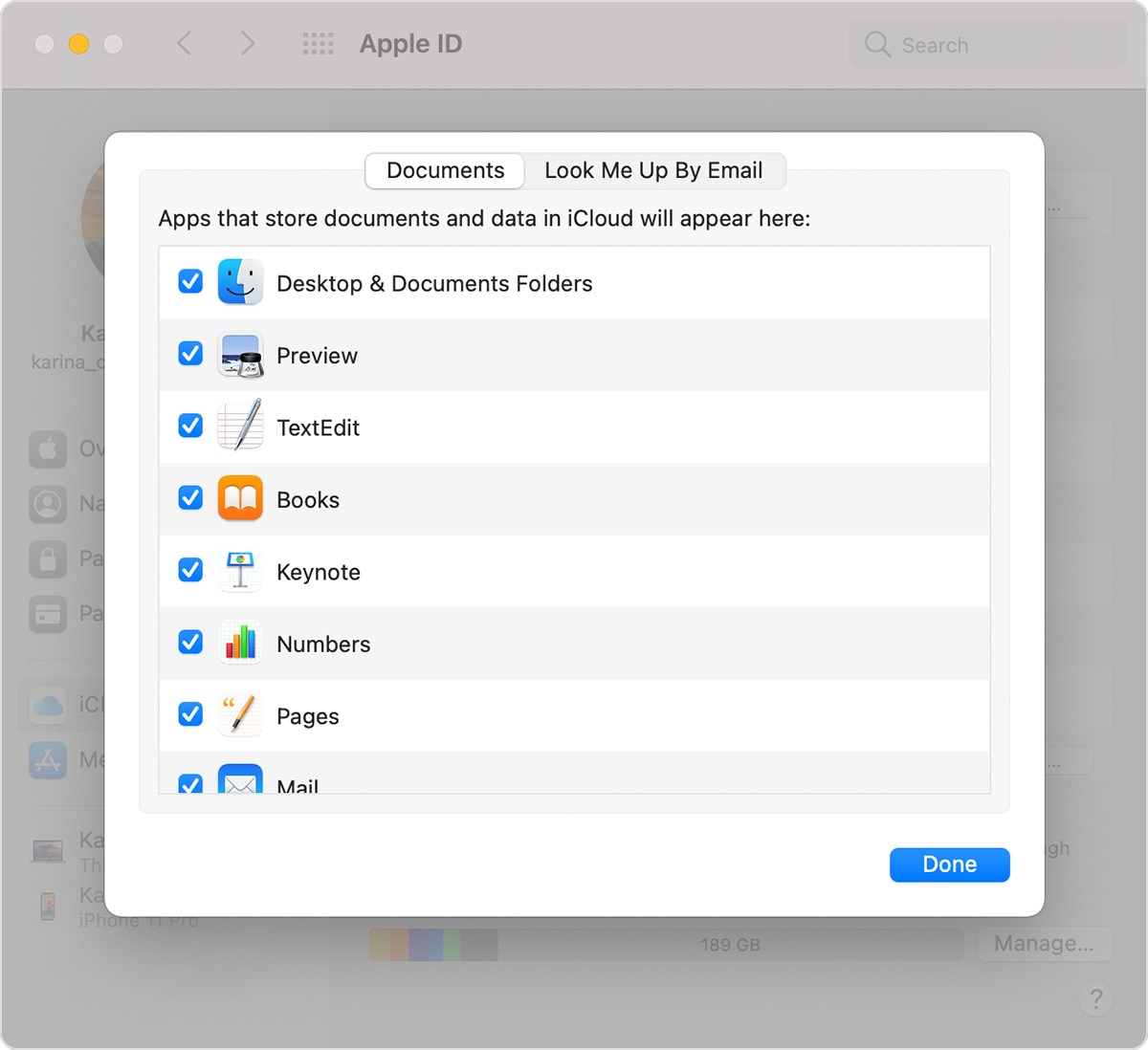Can I Upload Folders to Icloud Drive From My Pc
Add your Desktop and Documents files to iCloud Drive
Learn how to share your files from your Mac Desktop and your Documents folder to all of your devices with iCloud Bulldoze.

Turn on Desktop and Documents
Plough on Desktop and Documents on every Mac that you want to use with iCloud Bulldoze.
- From your Mac, cull Apple menu > Organisation Preferences. Click Apple ID, then click iCloud. In macOS Mojave or earlier, choose Apple menu > System Preferences, so click iCloud.
- Make sure that iCloud Bulldoze is turned on.
- Next to iCloud Drive, click Options.
- Cull Desktop & Documents Folders.

- Click Done.
If you want to shop your files in iCloud Drive and another cloud storage service, you tin keep copies of your files in both, but yous can't go on folders from a third-party cloud service in iCloud Bulldoze. You lot can keep your other cloud service folders in a different place on your Mac, similar the home folder.
If you already use a feature from another deject provider that syncs or manages your Desktop and Documents folders, you need to plow it off to use Desktop and Documents.
Notice your Desktop and Documents files on all of your devices
When you add your Desktop and Documents to iCloud Bulldoze, all of your files move to iCloud and any new files you create are automatically stored in iCloud too. Then you can find your files on all of your devices.
Your files upload to iCloud each time your device connects to the Internet. Depending on your Internet speed, the time it takes for you lot to see your files on your other devices might vary.
On your Mac
You tin can find your Desktop and Documents folders in the iCloud department of the Finder sidebar. If yous add a second Mac Desktop, yous tin discover those files in the Desktop binder in iCloud Bulldoze. Look for a folder with the same name equally your 2nd Mac. You tin also use Spotlight to search for specific file names.
On your iPhone, iPad, and iPod touch
Yous can detect the files in the Files app in iOS 11 or afterwards. You tin use any compatible app to access and edit your files direct on your iPhone, iPad, or iPod touch.
If you're using iOS 9 or iOS ten, you can access your files in the iCloud Drive app.
On iCloud.com
- Sign in to iCloud.com with your Apple ID on your iPad, Mac, or PC.
- Go to iCloud Drive.
- Double-click the Desktop or Documents folder.
If y'all want to use the file or make edits, simply click![]() and download information technology to your iPad or reckoner. When yous're done making edits, upload the file to iCloud Drive to meet the latest version everywhere.
and download information technology to your iPad or reckoner. When yous're done making edits, upload the file to iCloud Drive to meet the latest version everywhere.
Store your files in iCloud and salvage space on your device
The files that you continue in iCloud Bulldoze use your iCloud storage. And as long as you accept enough space in iCloud, y'all tin store as many files as you lot similar.
If you need more space, you tin delete files to free up space in iCloud. When you lot use iCloud Drive and delete a file on one device, it deletes on every device that you're signed in to with the same Apple ID. You tin discover deleted files in the Recently Deleted folder in the Files app or on iCloud.com for 30 days. Subsequently that, they're removed.
Learn more than almost how to manage your iCloud storage.
Plough off Desktop and Documents
- From your Mac, choose Apple tree carte > Arrangement Preferences. Click Apple ID, then click iCloud. On macOS Mojave or earlier, choose Apple carte > System Preferences, so click iCloud.
- Next to iCloud Drive, click Options.
- Deselect Desktop & Documents Folders.
- Click Washed.
What happens when you lot plough off Desktop and Documents
When you turn off Desktop & Documents Folders, your files stay in iCloud Drive and a new Desktop and Documents folder is created on your Mac in the home folder. You tin move files from iCloud Drive to your Mac as y'all need them, or select all of your files and drag them to the place y'all want to keep them.
What happens when you turn off iCloud Drive or sign out of iCloud
If you turn off iCloud Drive or sign out of iCloud, a new Desktop and Documents folder is created in your home folder. You also accept the option to go along a local copy of your files that are in iCloud Drive. If you go along a local re-create of your files in iCloud Drive, they're copied to a binder chosen iCloud Bulldoze (Archive) in your home binder. You lot tin can motility any files that were in your iCloud Desktop and Documents to your new local Desktop and Documents.
Published Date:
Source: https://support.apple.com/en-us/HT206985